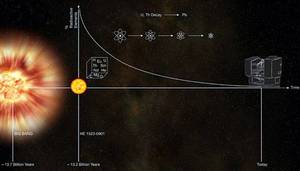Astronomers have used a unique process to determine that a star in our galaxy is nearly as old as the universe itself.

|
| ©ESO via livescience.com
|
| The Big Bang occurred 13.7 billion years ago, making the Milky Way star HE 1523 the oldest-known star at 13.2 billion years old. The star's age was gleaned from what's left of its radioactive elements compared to stable "anchor" elements, like europium, osmium, and iridium.
|
Comment: More
here. Waiting for more "dawn of time" dates to come.
Does your house address start with a 1? According to a strange mathematical law, about 1/3 of house numbers have 1 as their first digit. The same holds true for many other areas that have almost nothing in common: the Dow Jones index history, size of files stored on a PC, the length of the world's rivers, the numbers in newspapers' front page headlines, and many more.
The law is called Benford's law after its (second) founder, Frank Benford, who discovered it in 1935 as a physicist at General Electric. The law tells how often each number (from 1 to 9) appears as the first significant digit in a very diverse range of data sets.
A group of Russian scientists from Tomsk, Yekaterinburg, Nizhny Novgorod and Moscow have developed a series of unique compact generators capable of producing high-energy pulses of hundreds and even thousands of megawatts.
This compares with the capacity of a major Soviet hydropower station on the Dnieper or an energy unit at a modern nuclear power plant. The new generators are sources of electromagnetic radiation rather than electricity. Their main feature is a capacity to produce enormous power in a matter of nanoseconds. The impulses can be generated with a very high frequency.
Vice President of the Russian Academy of Sciences (RAS) Gennady Mesyats recalled that the first high-current electron accelerators were developed in the U.S.S.R. in the 1960s. Ten years later, Soviet scientists learnt to generate powerful microwave nanosecond pulses. The current generators have no counterparts in the world. In effect, Russian scientists have made a breakthrough in what is called relativist high-precision electronics.
Astronomers believe they may have found a significant portion of the universe's "missing" matter.
The mysterious dark matter may be giving invisible heft to small galaxies formed during galactic collisions, a new study says.
Dark matter is an invisible form of matter that does not give off or reflect light yet accounts for the vast majority of mass in the universe.
Scientists measured the mass of three so-called recycled dwarf galaxies near a massive galaxy that was recently in a collision.
The dwarfs appear to be more than twice as heavy as their visible stars and gas, indicating that they hold a type of dark matter.
Tiny igloos can generate "micro-tornadoes" in the lab, which could allow scientists to better understand the destructive secrets of real-life twisters-and maybe help predict them.
The translucent igloos, made of tiny water droplets and plastic balls, are only millimeters across. As these crystalline domes evaporate on Petri dishes-sometimes taking as long as nearly eight days to finish dissipating-they create micro-tornadoes under their roofs just roughly half the width of a human hair.
Real-life tornadoes are essentially natural engines, where warm, humid air from the ground rises upward into the colder atmosphere, converting heat into mechanical violence in the process. The result-the world's most powerful winds.
After Japanese insurance kingpin Yasuo Goto won a high-stakes bidding war by offering $39.9 million for a painting at a 1987 auction, an unforeseen controversy erupted: Was the painting, Vincent van Gogh's Still Life: Vase With Fifteen Sunflowers, truly the work of the Dutch master, or a clever fake?
Some art dealers and historians thought the character of the brushstrokes differed from other Van Goghs; others disagreed. The stalemate was never resolved. But after 20 years, help is finally arriving from an unlikely quarter. Computer scientist Richard Johnson of Cornell University in Ithaca, N.Y., is embarking on an international project to define Van Gogh's unique style in mathematical terms, with the intent of shining a focused beam of objectivity on the traditionally muddled question of attribution.
On May 14, teams of engineers that Mr. Johnson recruited will meet with art students and curators at the Van Gogh Museum in Amsterdam to announce what they think sets real Van Gogh paintings apart from forgeries. By analyzing a database of 101 paintings by the artist and his known imitators, the scientists have arrived at what they say are key elements of Van Gogh's "visual signature," which can be distilled into numbers. This, they say, will give art experts an important new tool to assess works like Vase With Fifteen Sunflowers. They can compare how closely a disputed painting's visual signature matches the baseline "signature" derived from the database.
Scientists have discovered how ocean circulation is working in the current that flows around Antarctica by tracing the path of helium from underwater volcanoes.
The team, which included researchers from the University of East Anglia, has discovered a 'short-circuit' in the circulation of the world's oceans that could aid predictions about future climate change.
This process in the Southern Ocean allows cold waters that sink to the abyss to return to the surface more rapidly than previously thought.
This affects the Southern Ocean circulation, which links all the other oceans, and is also relevant to uptake and release of carbon dioxide by the sea - transport between the deep and surface waters in the Southern Ocean is particularly important for this process.
Scientists examining documents dating back 3,500 years say they have found proof that the origins of modern medicine lie in ancient Egypt and not with Hippocrates and the Greeks.
The research team from the KNH Centre for Biomedical Egyptology at The University of Manchester discovered the evidence in medical papyri written in 1,500BC- 1,000 years before Hippocrates was born.
"Classical scholars have always considered the ancient Greeks, particularly Hippocrates, as being the fathers of medicine but our findings suggest that the ancient Egyptians were practising a credible form of pharmacy and medicine much earlier," said Dr Jackie Campbell.
"When we compared the ancient remedies against modern pharmaceutical protocols and standards, we found the prescriptions in the ancient documents not only compared with pharmaceutical preparations of today but that many of the remedies had therapeutic merit."
The medical documents, which were first discovered in the mid-19th century, showed that ancient Egyptian physicians treated wounds with honey, resins and metals known to be antimicrobial.
The team also discovered prescriptions for laxatives of castor oil and colocynth and bulk laxatives of figs and bran. Other references show that colic was treated with hyoscyamus, which is still used today, and that cumin and coriander were used as intestinal carminatives.
The genetic survey, produced by a collaborative team led by scholars at Cambridge and Anglia Ruskin Universities, shows that Australia's aboriginal population sprang from the same tiny group of colonists, along with their New Guinean neighbours.
Something weird hung high in the mid-morning sky earlier this week like a vision from Superman's home planet Krypton - a red sun.
OK, maybe not all that weird; after all, even the morning drive-time radio guys pointed out that smoke from Southwest Florida's wildfires had made the sun go red.

|
| ©Andrew West/news-press.com
|
| Smoke from recent fires have created stunning sunsets like this one over the Sanibel Causeway April 30 and Wednesday's red sun
|

Comment: More here. Waiting for more "dawn of time" dates to come.